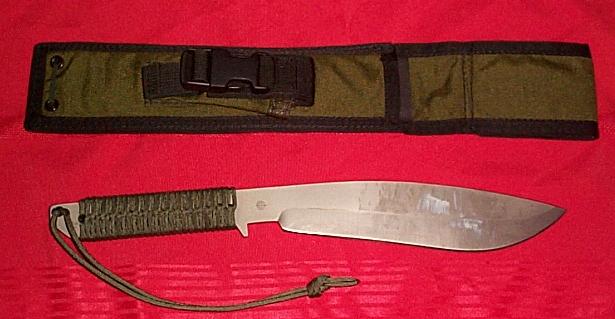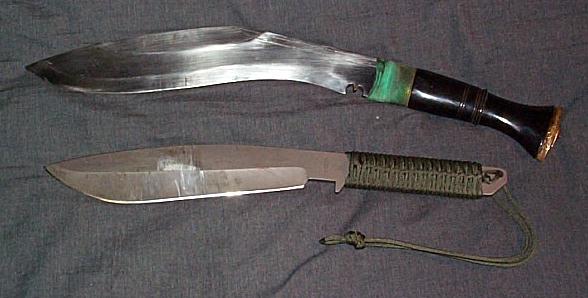
The blade is ground from 1/4" thick ATS-34 heat treated by Paul Bos. It is 14.75" long with a blade length of 9.25". The tang is quite slim which concentrates the balance far forward giving it a powerful heft for its relatively low mass. It has a deep sabre hollow grind. The edge bevel is a dual flat grind of about 22 degrees. The sheath is made from a combination of Cordura and Kydex by Special Operations Equipment :

with the Battle Mistress from Busse Combat :

and alongside an 18 inch Ang Khola khukuri from Himalayan Imports :

With the slope of the blade and the steep curvature, the slicing ability is enhanced similar to a recurved blade. The deep hollow grinds allowed it to bite in very well without an excessive amount of force being required to wedge the material apart and could handle thick cord without difficulty. The same geometrical advantages allowed it to cleanly cut through bundles of thick fabric without requiring excessive amount of force as well as gliding easily through layers of thick webbing.
In the kitchen, the PAB's curvature allows it to chop vegetables in a rocking motion. Outside the kitchen this same method was used to severe small sticks in neat sections as well as push cut through very thick cord using easily 1/3 as much force as a straight push cut. Even 3/8" thick hemp was smoothly cut with ease. To get a little more specific, the PAB would cut through 1/2" hemp rope using a rocking motion using 60 +/- 2 lbs, with 63 +/- 2 lbs required for the Battle Mistress.
Whittling wood, the PAB and Battle Mistress were in the same performance class, the PAB would generally require say about 12 cuts to match ten from the Battle Mistress. A drop point hunter from David Boye was used as a very high benchmark, close to optimal performance :
| Model | Primary grind | Edge angle | Edge width | Ranking |
|---|---|---|---|---|
| Boye | full flat | 22 | 0.005 | 100 |
| Battle Mistress | full flat | 15 | 0.108 | 60 +/- 5 |
| PAB | deep hollow | 22 | 0.043 | 44 +/- 2 |
The edge angle on the Battle Mistress had been reduced was new. If both blades had no modifications then the performance would likely be near idential. One of the more interesting aspects of the above performance is that the deep primary hollow grind of the PAB allows it to cut at a near equal level as compared to the much more acute edge profile on the Battle Mistress.
In essence, the deeper promary grind allows a more durable edge given a particular required performance for shallow cutting. This of course leaves the blade body grind weaker so if the edge durability is exceeded then there can be primary grind blowouts : ref. The hollow primary grind also had a wedging drawback, on deep cuts with the PAB the blade would tend to bind as the cut depth approached the height of the primary grind. This was readily seen doing simple cutting like slicing up thick vegetables The same drawback makes itself seen during heavy chopping.
The PAB has a thin edge, a forward balance, solid weight, and a comfortable and secure handle which allows a powerful stroke without fear of loss of control or excessive hand damage. Using the PAB limbing out and clearing out small dead-fall, It easily handled the light wood chopping and switching back and forth between it and the Battle Mistress, neither held an advantage in regards to cutting ability. The penetration was solid and the binding was low with the shallow penetration achieved.
Using a pile of scrap, the PAB and the Machax from Camillus were used to chop up a few dozen pieces of wood. The wood was small from about 1" square up to about a 2x3". The PAB consistently required significantly less chops but would bind more especially on press board.
| Model | Mass | Primary grind | Edge grind | Edge width | Ranking |
|---|---|---|---|---|---|
| grams | |||||
| PAB | 500 | deep hollow | 20 | 0.053 | 100 |
| Machax | 620 | 6-7 | 15 | 0.135 | 62 (10) |
| Machax (edge mod) | 12 | 0.250 | 100 (8) | ||
The edge on the Machax in the above had been made significantly more acute than the new in box profile. Even though the Machax is about 25% heavier with similar balance and more acute edge, the deep hollow grind of the PAB gave greater penetration compared to the flat sabre grind of the Machax. Specifically 1/4" back from the edge the PAB is 0.05" thick, the Machax is almost three times as thick at this point.
The Machax was further reground, the edge was thinned and the primary grind made more acute and the depth extended. Using both blades limbing and light clearing they seemed indistinguishable. On more scrap, larger pieces of wood this time, ranging from 1-2" thick and 1-6" wide. Two dozen pieces were cut with each blade and the performance was consistently even as noted in the above table.
It is interesting to note just how low the edge on the Machax had to be taken to so as to allow it to reach equal penetration. The Machax tended to suffer edge deformation which lead to chipping even with the initial edge profile of about 26 degrees per side . Once thinned to under half much more extensive edge damage resulted. The edge on the Machax now chipped out all along the contact area. Dented and chipped in about 12 places, most were just large enough to feel with by thumbnail but a couple were large enough to be visible.
While the raw chopping ability was on lumber (2x4's) was about 80% that of the Gransfors Bruks Wildlife hatchet, on actual fresh wood the binding was very high. On heavy chopping the PAB had to be frequently beaten out of the wood with another piece of wood. To fix this problem change the primary geometry to a dual convex taper. The primary convex grind runs from about 2/3 height to form the edge and then another runs the other 1/3 of the way up at a larger radius of curvature to slim out the spine. This increases cutting ability, reduces wedging, and greatly raises impact toughness. In terms of blade size, for general brush work about 14" is a personal preference. Beyond that knife work gets very difficult.
Before the above second round of scrap chopping, both blades were sharpened to a high polish, 0.5 Micron chromium oxide sandpaper. The PAB needed 120 +/- 7 g to cut the thread, while the Machax 130 +/- 17, both readily shaved. The slicing ability of the blades on 1/4" poly cord to determine the cutting ability based on the number of slices required to cut through the cord under the blades own weight. This was done before and after the second set of scrap chopping described in the above (~175 chops with each blade). The results :
| Model | Edge grind | Edge width | Before | After | Edge loss |
|---|---|---|---|---|---|
| % | |||||
| PAB | 22 | 0.043 | 4.9 +/- 1.1 | 7.3 +/- 0.6 | 33 +/- 8 |
| Machax | 12 | 0.250 | 1.8 +/- 0.1 | 4.9 +/- 0.3 | 63 +/- 5 |
The PAB retained more of its cutting ability, however the geometry of the Machax does lead to great slicing ability. As the cord ramps along the extreme curvature great pressure is transferred which increases slicing aggression. The edge chipping also acts as small serrations it also weighs 25% more so it has a greater load behind the slice.
UPDATE : this should have been repeated at least once to check for stability. Sharpness should also in general checked both on the push and pull as they in general don't blunt to the same extent. As the angles are different the above can't be used to generalize about the steels, though it does make a point about edge retention as influence by geometry. Note the Machax after blunting is cutting the same amount as the PAB when freshly sharpened.
The cord wrap handle on the PAB offers great security through multiple high pressure points due to the raised knots of the cord wrap, it has a similar effect as an aggressive checkering on the Reeve one-piece line, but on a larger scale. The grip is secure even in the worst conditions with the hand covered in oil, soaps or fat.
In regards to ergonomics, the major factor in comfort is the individuals hand strength and durability. Some friends described the PAB as nonfunctional as the handle was far too abrasive. Personally a larger problem was was very difficult to clean.
In late summer the sap on many felled trees rots and turns into a very slick fluid. On knives with simple scales this sludge can be scrubbed off, however it goes into the cord and is very difficult to remove. An epoxy + cord wrap is far easier to clean. In general an actual shaped grip with an aggressive texture is superior. The cord can also be readily cut or abraded.
Comments can be sent to : cliffstamp[REMOVE]@cutleryscience.com or by posted to :
For further information visit Strider's website.
| Last updated : | 01 : 10 : 2006 |
| Originally written: | 7 : 27 : 2001 |